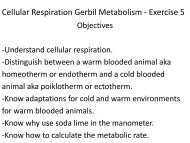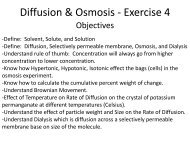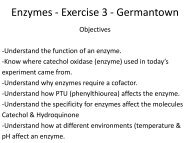Chapter 8: Alkynes - Science Learning Center
Chapter 8: Alkynes - Science Learning Center
Chapter 8: Alkynes - Science Learning Center
Create successful ePaper yourself
Turn your PDF publications into a flip-book with our unique Google optimized e-Paper software.
<strong>Alkynes</strong><br />
<strong>Alkynes</strong>-hydrocarbons with a carbon-carbon triple bond.<br />
The carbon-carbon triple bond results from the interaction of two sp hybridized carbon<br />
atoms. 180 degree angle. Linear.<br />
The carbon-carbon triple bond is the shortest and strongest known<br />
carbon-carbon bond. Why? It has the highest percentage of s character.<br />
Type Hybridization % s character % p character<br />
Alkane sp 3 25 75<br />
Alkene sp 2 33 67<br />
Alkyne sp 50 50<br />
Nomenclature<br />
<strong>Alkynes</strong> are named like alkenes with the following adjustments: 1) Number the carbons<br />
on the chain so that the triple bonded carbons receive the lowest possible numbers, 2)<br />
Indicate the location of the triple bond by writing the number of the lowest numbered<br />
carbon making up the triple bond in front of the name of the parent chain. 3) Change the<br />
ending from –ene to –yne.<br />
Reactions to Know<br />
Preparation of <strong>Alkynes</strong><br />
Synthesis of <strong>Alkynes</strong>:<br />
1. Dehydrohalogenation of vicinal dihalides:<br />
Br<br />
R<br />
H<br />
C<br />
Br<br />
C<br />
H<br />
R<br />
2 Alc. KOH<br />
R<br />
C C R<br />
Note: vic-dihalides are prepared from alkenes. Thus, in effect, this is a conversion of<br />
alkene to alkyne.
Reactions of <strong>Alkynes</strong><br />
1. Hydrohalogenation:<br />
X<br />
H<br />
R<br />
C<br />
C<br />
R<br />
2 HX<br />
R<br />
C<br />
C<br />
R<br />
X<br />
H<br />
(Geminal Dihalide)<br />
2. Mercury (II)-Catalyzed Hydration:<br />
R<br />
C<br />
C<br />
H<br />
OH<br />
H 2 O, H 2 SO 4<br />
HgSO 4<br />
R C C<br />
(Ketone)<br />
The enol is an intermediate in the reaction. However, it immediately rearranges to form<br />
the a ketone through a process called keto-enol tautomerism.<br />
3. Hydroboration-Oxidation: (Internal alkynes will give a ketone; terminal alkynes<br />
will give an aldehyde).<br />
Enol<br />
H<br />
H<br />
R<br />
C<br />
H 2<br />
O<br />
C<br />
CH3<br />
OH<br />
O<br />
R C C R<br />
1) BH 3<br />
2) H 2 O 2 , OH<br />
R C C<br />
H<br />
R<br />
R<br />
C<br />
C<br />
H 2<br />
R<br />
Enol<br />
(Ketone)
As in the mercury-catalyzed reaction, the enol is an intermediate which quickly<br />
undergoes keto-enol tautomerism to form the ketone.<br />
H<br />
BR<br />
1) BH 2<br />
3<br />
R C C R C C<br />
2) H 2 O 2 , OH R C C<br />
R<br />
R<br />
H<br />
Enol<br />
OH<br />
R<br />
Examples:<br />
a) Internal alkyne to ketone<br />
OH<br />
1) BH 3<br />
H 3 C C C CH 3<br />
2) H 2 O 2 , OH<br />
H 3 C C C CH 3<br />
b) Terminal alkyne to aldehyde<br />
OH<br />
H<br />
Enol<br />
1) BH 3<br />
H C C CH 3<br />
2) H 2 O 2 , OH<br />
H C C CH 3<br />
4. Hydrogenation:<br />
H<br />
Enol<br />
R<br />
O<br />
C<br />
C<br />
H 2<br />
O<br />
R<br />
H 3 C C C CH 3<br />
H 2<br />
O<br />
H C C CH 3<br />
H 2<br />
R<br />
C<br />
C<br />
R<br />
2 H 2 / Pd<br />
R<br />
H<br />
C<br />
H<br />
C<br />
R<br />
(Alkane)<br />
H<br />
H<br />
5. Hydrogenation Using Lindlar Catalyst:<br />
H<br />
H<br />
R<br />
C<br />
C<br />
R<br />
H 2<br />
C C<br />
Lindlar's cat.<br />
R<br />
R<br />
(Cis Alkene)
6. Hydrogenation Using Lithium and Ammonia (Na can be used instead of Li):<br />
H<br />
R<br />
R<br />
C<br />
C<br />
R<br />
Li, NH 3<br />
C C<br />
(Trans Alkene)<br />
R<br />
H<br />
7. Cleavage of Internal <strong>Alkynes</strong>:<br />
R<br />
C<br />
C<br />
R'<br />
KMnO 4 or<br />
O 3<br />
O<br />
O<br />
R C OH + R' C OH<br />
(Carboxylic Acid)<br />
8. Cleavage of Terminal <strong>Alkynes</strong>:<br />
R<br />
C<br />
C<br />
H<br />
KMnO 4 or<br />
O 3<br />
O<br />
R C OH + CO 2<br />
(Carboxylic Acid and CO 2 )<br />
9. Alkylation Using Acetylide Ions:<br />
R<br />
C<br />
C<br />
H<br />
1) NaNH 2 , NH 3<br />
2) R'CH 2 Br<br />
R<br />
C<br />
C<br />
CH 2 R'
Practice Problems:<br />
1) What are the products of the following reaction:<br />
a)<br />
H 3 C C C CH 2 CH 3 ?<br />
Li, NH 3<br />
b)<br />
H 3 C C C H<br />
c)<br />
KMnO 4 or<br />
O 3<br />
1) BH 3<br />
H C C CH 2 CH 3<br />
2) H 2 O 2 , OH<br />
?<br />
Answer<br />
Answer<br />
Answer<br />
Alkyne Acidity: Forming Acetylide Anions<br />
Terminal alkynes are weakly acidic.<br />
Acidity of simple hydrocarbons:<br />
<strong>Alkynes</strong> > Alkenes> Alkanes<br />
Why are terminal alkynes more acidic than alkenes or alkanes? Acidity depends upon the<br />
stability of the conjugate base. Why are acetylide anions more stable than vinylic or alkyl<br />
anions?<br />
1) Hybridization of the negatively charged carbon atom:<br />
a. Acetylide anion has an sp hybridized carbon. Therefore,<br />
the negative charge resides in an orbital that has 50% s<br />
characteristic.<br />
b. Vinylic anion ' sp2 hybridized. 33% s character.<br />
c. Alkyl anion ' sp3 hybridized. 25% s character.<br />
Since s orbitals are nearer the positive nucleus and are lower in energy than p orbitals, the<br />
negative charge is stabilized to a greater extent.<br />
1. Formation of Acetylide Anions<br />
RC C H NH 2 Na + RC C Na + NH 3<br />
Acetylide anion<br />
Acetylide Anions are important to organic synthesis because they can be used to make a<br />
carbon chain longer.
2. Alkylation of Acetylide Anions<br />
RC C + 1° RX ! RC CR<br />
You’ll learn the mechanism for this reaction in a later chapter.<br />
Practice Synthesis Problem:<br />
H 3 CH 2 C<br />
CH 3<br />
H from H 3 CH 2 CC<br />
C<br />
C<br />
2) How could you prepare<br />
needed reagents?<br />
H<br />
CH and any<br />
Answer
Answer<br />
1) What are the products of the following reaction:<br />
a)<br />
H 3 C C C CH 2 CH 3 ?<br />
Li, NH 3<br />
H 3 C C C CH 2 CH 3 C C<br />
Li, NH 3<br />
H<br />
CH 2 CH 3<br />
H 3 C<br />
H<br />
Return to Problem
Answer<br />
1) What are the products of the following reaction:<br />
b)<br />
H 3 C C C H<br />
KMnO 4 or<br />
H 3 C C C H<br />
O 3<br />
KMnO 4 or<br />
O 3<br />
H 3 C C OH<br />
O<br />
CO 2<br />
Return to Problem
Answer<br />
1) What are the products of the following reaction:<br />
c)<br />
1) BH 3<br />
H C C CH 2 CH 3<br />
2) H 2 O 2 , OH<br />
?<br />
H C C CH 2 CH 3<br />
1) BH 3<br />
2) H 2 O 2 , OH<br />
HC CH2 CH 2 CH 3<br />
Return to Problem<br />
O
Answer:<br />
H 3 CH 2 C<br />
CH 3<br />
H from H 3 CH 2 CC<br />
C<br />
C<br />
2) How could you prepare<br />
needed reagents?<br />
H<br />
CH and any<br />
H 3 CH 2 CC<br />
CH<br />
NaNH 2<br />
H 3 CH 2 CC<br />
C<br />
BrCH 3<br />
H 3 CH 2 C<br />
H<br />
C<br />
C<br />
CH 3<br />
H 2<br />
H Lindlar's Catalyst<br />
H 3 CH 2 CC CCH 3<br />
Return to Problem







